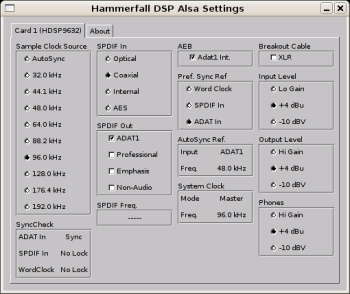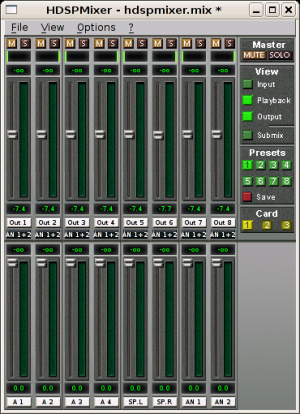Chapter 2. Hardware
This section will explain some specific hardware installation. Please, feel free to send me documentation patches for this section with your own experimentation.
2.1. RME Hammerfall HDSP 9632

2.1.1. Firmware
Thanks to Paul Davis and others it exists some kernel stuff for RME HDSP support. However not all firmware versions are supported by old ALSA drivers. ALSA drivers (>= 1.0.14rc1) are ok[1].
Depending on your firmware and ALSA version you will sometime need to downgrade the firmware of your card (but, I repeat, this operation is not needed anymore with ALSA drivers >= 1.0.14rc1). To do this, download a older firmware from the RME website. You will need the 1.51 version. You will find it on the RME archives (under the "HAMMERFALL DSP DRIVERS"). You must download a file named fut_win_dsp.zip.
Once you have downloaded this file, save it on a USB key and reboot on Windows. Then just unzip the file and click on the hdsp_fut.exe file. Do not take in account Windows alerts and click on the update button. Then reboot.
If all was fine, your firmware version should be 1.51 (or 151) on Windows and lspci should output rev97 on GNU/Linux:
$ lspci | grep -i rme
04:01.0 Multimedia audio controller: Xilinx Corporation RME Hammerfall DSP (rev 97)
2.1.2. Linux Kernel
First, take a look at Section 1.3 if you are not confident with kernel compilation.
You will need to compile the snd-hdsp ALSA module.
Device Drivers --->
Sound --->
<M> Sound card support
Advanced Linux Sound Architecture --->
<M> Advanced Linux Sound Architecture
PCI devices --->
<M> RME Hammerfall DSP Audio
Then reboot or load the new module as root with modprobe snd-hdsp.
2.1.3. HDSP utilities
Thanks to Thomas Charbonnel and others RME HDSP soundcards have special mixer and configurator GUI. Those tools are in the alsa-tools-gui archive downloadable from the ALSA Web site or packaged for you own GNU/Linux distro.
2.1.3.1. hdspconf
Use this tool to control the basics of your board. In my case I had to check the checkbox and radio button in order to have the AEB 4/I expansion fonctionnal.
2.1.3.2. hdspmixer
There is no conventional mixer on this card, so alsamixer and other "generic mixer" applications will do nothing. You will have to use hdspmixer every time you will need to capture/produce sound.

